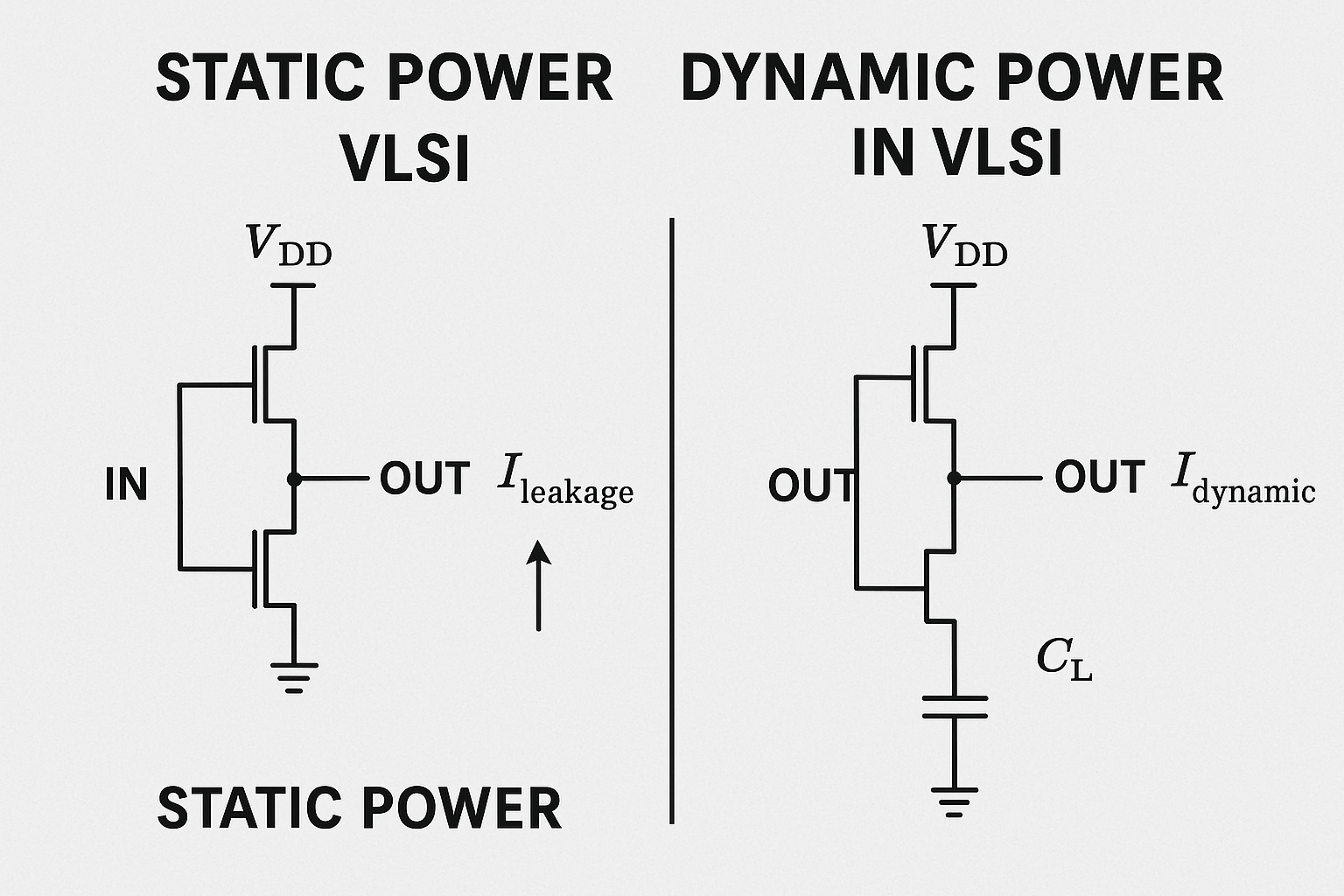In VLSI (Very Large Scale Integration) design, understanding the distinction between static power and dynamic power is crucial for optimizing the performance and power efficiency of modern integrated circuits. Both types of power consumption have different characteristics and implications in the design and operation of digital circuits.
1. Static Power in VLSI
Static power refers to the power consumed by a circuit when it is not actively switching. This type of power dissipation primarily results from leakage currents that flow through transistors even when they are in a steady state.
Key Characteristics of Static Power:
- Leakage Current: The primary source of static power is the leakage current, which flows even when transistors are turned off.
- Subthreshold Conduction: When the gate-to-source voltage is below the threshold, a small subthreshold current flows, contributing to static power dissipation.
- Gate Oxide Leakage: As transistors shrink to smaller nodes, the gate oxide thickness decreases, leading to increased leakage currents.
- Temperature Dependence: Static power increases with temperature due to higher leakage currents at elevated temperatures.
Factors Affecting Static Power:
- Technology Node: Smaller process nodes (e.g., 7nm or 5nm) have increased leakage currents, causing higher static power dissipation.
- Supply Voltage: The power consumed due to leakage current is proportional to the supply voltage, so higher voltages increase static power.
- Transistor Threshold Voltage: Lower threshold voltages increase leakage current, thus raising static power consumption.
2. Dynamic Power in VLSI
Dynamic power is the power consumed during the switching of transistors in a circuit. This type of power is associated with the charging and discharging of capacitive loads during each logic transition.
Key Characteristics of Dynamic Power:
- Switching Events: Dynamic power consumption occurs when a circuit’s output switches from 0 to 1 or 1 to 0.
- Capacitive Load: The switching power is related to the capacitance that needs to be charged or discharged during logic transitions.
- Voltage Swing: The power is proportional to the square of the supply voltage. Higher voltage swings lead to higher dynamic power consumption.
Formula for Dynamic Power:
The dynamic power can be calculated as:
Pdynamic=C⋅V2⋅f⋅α
Where:
- Pdynamic = Dynamic power
- C = Load capacitance
- V = Supply voltage
- f = Switching frequency
- α = Activity factor (the fraction of time a signal switches)
Factors Affecting Dynamic Power:
- Switching Frequency (f): The power consumed increases with higher switching frequencies.
- Capacitance (C): More capacitance, such as larger gate sizes or longer interconnects, increases dynamic power dissipation.
- Supply Voltage (V): Higher supply voltages significantly increase dynamic power consumption.
- Activity Factor (α): A higher activity factor (more frequent switching) leads to increased dynamic power.
Static Power vs. Dynamic Power: Key Differences
| Aspect | Static Power | Dynamic Power |
| Definition | Power consumed when the circuit is idle or not switching. | Power consumed during active switching. |
| Source | Leakage current (subthreshold, gate oxide leakage). | Charging and discharging of capacitance. |
| Dependence on Voltage | Increases with voltage and process node scaling. | Increases with the square of voltage. |
| Dependence on Frequency | Not dependent on frequency. | Directly proportional to frequency. |
| Impact on Low-Power Designs | Major concern for battery-powered devices. | Dominates in high-speed circuits and dynamic systems. |
| Factors Affecting | Voltage, frequency, capacitance, and activity factor. | Voltage, frequency, capacitance, activity factor. |
| Contribution in Modern Chips | Significant in small nodes (7nm, 5nm). | Dominates in high-performance chips. |
| Control Mechanism | Reduced by using high-threshold transistors or power gating. | Reduced by optimizing clock frequency and voltage scaling. |
3. Key Differences in Power Dissipation
- Static Power: Static power is primarily a result of leakage current in transistors and is mostly independent of circuit switching. As semiconductor technology shrinks, static power dissipation becomes more significant due to increased leakage currents, particularly in advanced process nodes.
- Dynamic Power: Dynamic power is related to the active switching of circuits and is dependent on the switching frequency and capacitance. Higher voltage, frequency, and capacitance increase dynamic power dissipation. Dynamic power is dominant in high-performance systems like processors and memory circuits.
4. Power Optimization in VLSI
- Static Power Reduction:
- Use of High Threshold Voltage Transistors: By using transistors with higher threshold voltages, static power dissipation can be reduced.
- Power Gating: Power gating techniques involve turning off power to portions of the circuit that are not in use, reducing leakage currents.
- Dynamic Power Reduction:
- Dynamic Voltage and Frequency Scaling (DVFS): DVFS reduces the supply voltage and frequency of the system to lower dynamic power during idle or less-intensive operations.
- Clock Gating: Clock gating is used to stop the clock signal in unused portions of the circuit, reducing dynamic power consumption.
- Low Power Design Techniques: Techniques such as multi-threshold CMOS (MTCMOS) and adapting the voltage levels help in minimizing dynamic power.
5. Conclusion: Managing Power in VLSI
In VLSI design, the optimization of both static and dynamic power is crucial for developing efficient and high-performance systems. While static power dissipation becomes more prominent with smaller process nodes and higher leakage currents, dynamic power is the major concern in high-speed systems. Power management techniques like dynamic voltage scaling, clock gating, and power gating help in balancing the trade-offs between performance and power efficiency, particularly in low-power applications such as mobile devices, IoT, and wearable technologies.
By managing both static and dynamic power dissipation, engineers can design energy-efficient circuits for a variety of modern applications, from consumer electronics to high-performance computing.










Leave feedback about this